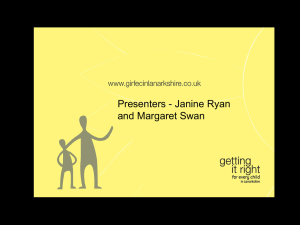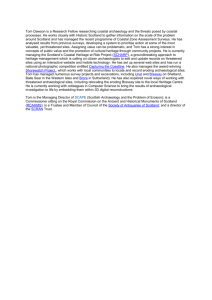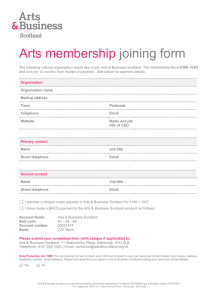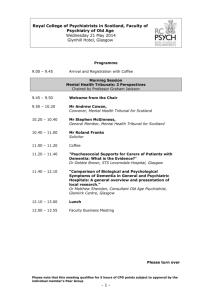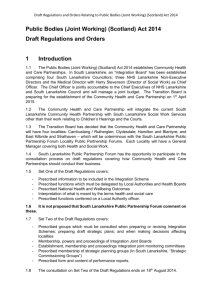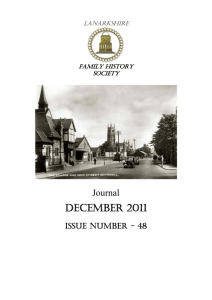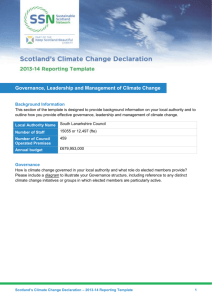Archaeological-Study
advertisement
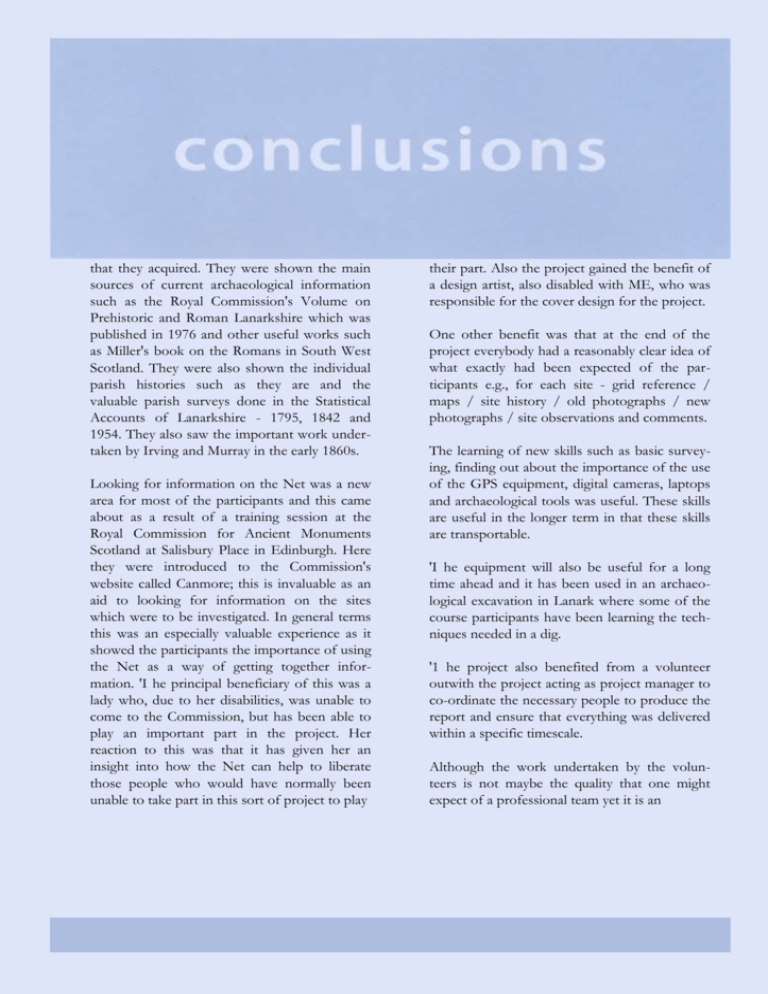
that they acquired. They were shown the main sources of current archaeological information such as the Royal Commission's Volume on Prehistoric and Roman Lanarkshire which was published in 1976 and other useful works such as Miller's book on the Romans in South West Scotland. They were also shown the individual parish histories such as they are and the valuable parish surveys done in the Statistical Accounts of Lanarkshire - 1795, 1842 and 1954. They also saw the important work undertaken by Irving and Murray in the early 1860s. Looking for information on the Net was a new area for most of the participants and this came about as a result of a training session at the Royal Commission for Ancient Monuments Scotland at Salisbury Place in Edinburgh. Here they were introduced to the Commission's website called Canmore; this is invaluable as an aid to looking for information on the sites which were to be investigated. In general terms this was an especially valuable experience as it showed the participants the importance of using the Net as a way of getting together information. 'I he principal beneficiary of this was a lady who, due to her disabilities, was unable to come to the Commission, but has been able to play an important part in the project. Her reaction to this was that it has given her an insight into how the Net can help to liberate those people who would have normally been unable to take part in this sort of project to play their part. Also the project gained the benefit of a design artist, also disabled with ME, who was responsible for the cover design for the project. One other benefit was that at the end of the project everybody had a reasonably clear idea of what exactly had been expected of the participants e.g., for each site - grid reference / maps / site history / old photographs / new photographs / site observations and comments. The learning of new skills such as basic surveying, finding out about the importance of the use of the GPS equipment, digital cameras, laptops and archaeological tools was useful. These skills are useful in the longer term in that these skills are transportable. 'I he equipment will also be useful for a long time ahead and it has been used in an archaeological excavation in Lanark where some of the course participants have been learning the techniques needed in a dig. '1 he project also benefited from a volunteer outwith the project acting as project manager to co-ordinate the necessary people to produce the report and ensure that everything was delivered within a specific timescale. Although the work undertaken by the volunteers is not maybe the quality that one might expect of a professional team yet it is an important addition to the knowledge of local history / archaeology within the designated area. In addition it does pull together a bit of new knowledge which has not previously seen the light of day. In conclusion one of the most significant achievements was that the group decided that they would like to build on the project using the skills that they had already acquired. Their vision was that, subject to finance and approval, they would like to learn how to use a resistivity meter, do more fieldwalking and do a small scale excavation. '1 hey wanted to use a resistivity meter to find out more about such sites as Castledykes where excavation would not be permitted - see recommendation section for further information. Carrying out fieldwalking in a number of localities near sites that are little known would be useful, for example, Castle Qua. They were also keen to participate in a targeted excavation which would be small and manageable, but useful. It was felt that Wilsontown Ironworks would be the best site for this. Problems The number of sites was too ambitious in terms of the capabilities of the volunteers to deliver results within the time schedule. '1 here were two principal reasons - the first being training. It had been anticipated that the training would give the volunteers the confidence to go and look at a site with a view to making a report on it. his was to involve a lot more training than was originally anticipated. What had not been foreseen was just how much training would be necessary to give each person the confidence to tackle the assigned projects. Since this project was to be open to all, it was inevitable that the people taking part would come from a wide sector of society with varying skills and abilities. It is only now towards the end of the project that the majority of the group are acquiring all the necessary skills to make a difference. In effect, what was being attempted was to give the participants the equivalent academic skills to a first year Archaeological Student. Obviously this was not possible given the time constraints and the spreading out of the course over almost a year, but in effect this was about six months as the specialized equipment did not come till May. For a variety of reasons, the training sessions had to be spread over a number of months and it was not possible to do the training sessions when the trainer would have preferred. However the main overall introductory training session was good but, due to the budget and costs restraints, it was not possible to have a trainer on the visits. 'this would have speeded up the visits and reporting. However, part of the overall aim of the project was that the participants, with some guidance, would be responsible to some degree for their own learning. Since several people joined the project after it was started there were inevitably problems about people being focused on what exactly was happening in the project and precisely where it was going to end up. '1 his was put to bed at the end of the project, but the point was taken that the focus of the project should have been much clearer at the beginning and a project objective sheet should have been issued. This comment has been taken on board for future projects as a better way to manage a project. Originally it had been anticipated that Derek Alexander, the National Trust Archaeologist for Southern Scotland would play a prominent part in the training of the volunteers and the assessment of the sites suitable for further investigation. In reality this proved impossible due to the reorganization and reassignment of tasks within the National Trust for Scotland which is currently undergoing a major restructuring exercise, so the burden of undertaking the role of Archaeological Consultant and trainer fell on the shoulders of Ed Archer, Development Officer of CSV/RSVP. Unfamiliarity with equipment was another stumbling block, in particular if a change had been made in the way that it operated. 'I he GPS acquired for the project did not give the grid reference as another one of exactly the same type. Fortunately for some of the time another but older model was borrowed. Another problem was to face the volunteers and that was the weather. This summer was one of the worst on record for rain, so this obviously curtailed the number of opportunities for investigation of the sites. Other minor problems included illnesses and other similar issues. However, despite all these issues and those previously mentioned, the volunteers managed to accomplish a great deal during their involvement in the project. If the weather in itself was a problem there was the foot and mouth epidemic which effectively put most of the sites out of bounds for visiting. Though the chances of spreading the disease were minimal, it was felt that it was better to be safe than sorry and respect the control orders that were put in place. Altogether three weeks investigation time was lost due to this. But, fortunately, there was time enough to bring the project back on track. Recommendations The group decided after some discussion with the Archaeological consultant that they would like to progress the project in a number of ways. The first idea was to do a more in-depth study on certain places that were on the project list. The site that appealed to everybody was Eastshield Farm as the group had been given permission to copy a family history '1 his was felt to be a good idea as it would add to the work already undertaken there and could be easily added to information already researched. The same idea could also be applied to other sites that have proved very interesting and exciting. Fieldwalking was also high up on the agenda. The success which members have had with this particular mode of research has been noteworthy and it was felt that, if it was done near the sites that had been difficult to write up, then it might provide additional interesting information. Use of the Resistivity Meter was seen as definitely useful especially in areas which were scheduled under the Ancient Monuments Act. Castledykes was thought to be a site meriting this particular type of investigation. Some investigation has already been undertaken using this method at Castledykes and the results have been very encouraging and, since there were done, a new piece of software has been created which now permits vertical surveys to be done. It was also thought that this type of equipment could be used at Blackcastle to try and locate the original Blackcastle that gave the present farm its current name. Excavation was discussed and it was thought that two small scale excavations could be done and it was felt that excavating two dwelling house sites would be useful. The site for this would be Wilsontown as it would be ideal for just such an exercise and could be done with Historic Scotland and the Forestry Commission. Also it would tie in with the considerable local interest that the site has engendered. The same idea could also be applied to other sites that have proved very interesting and exciting. Acknowledgements Bibliography Derek Alexander - National Trust The following sources of information have been consulted: 'I he Statistical Accounts of Scotland Edinburgh 1791 -9 New Statistical Account of Scotland, Edinburgh, 1845 Irving and Murray - 'I he Upper Ward of Lanarkshire described and delineated, Glasgow, 1864 Royal Commission on Ancient and Historic Monuments of Scotland - Prehistoric and Roman Lanarkshire - HMSO - 1978 Proceedings of the Society of Antiquaries - report on Hyndford Crannog -1898-1899 Miller - The Roman Occupation of South West Scotland, Glasgow University, 1952 Professor Ann Robertson - 'I he Excavations at Castledykes - Glasgow University - 1964 James Wilson - A contribution to the History of Lanarkshire - 2 Volumes - Glasgow - 1936 Calendar of Documents relating to Scotland Volume VI - Scottish Record Office Nigel Tranter - The Fortified House in Scotland South West Scotland - James Thin - 1977 Caroline Robison - Wilsontown - A study in Entreprenurial Failure (1779-1813) Archaeological Adviser Ed Archer - Archaeological Consultant Chic Meehan - Project production Manager Ian Wallace - Finance Organizer Andrew Wallace - Report Collator and Organizer Royal Commission of Ancient Monuments Scotland National Library of Scotland - Map Department Paul Archibald and Ian McIver Lanark Library Scottish Forestry Commission All the property owners who gave access to members of the study group All the members of the national bodies mentioned above and who helped the volunteers Other works have been referred to through the project but chiefly through information held by the Royal Commission in Edinburgh Maps too have been consulted principally Timothy Pont - Map Of Lanarkshire - 1596 J. Blaeu - Upper and Lower Wards of Lanarkshire - 1654 William Roy's Map of Lanarkshire - 1764 Forrest's Map of Lanarkshire - 1819 Ordnance survey maps from 1859 - present day
